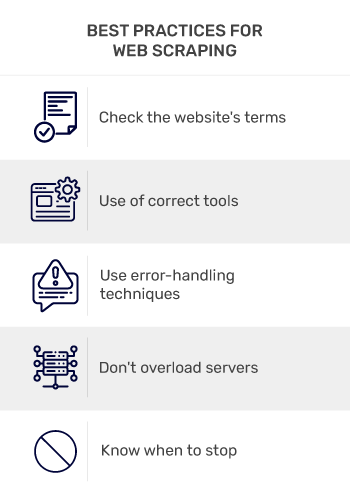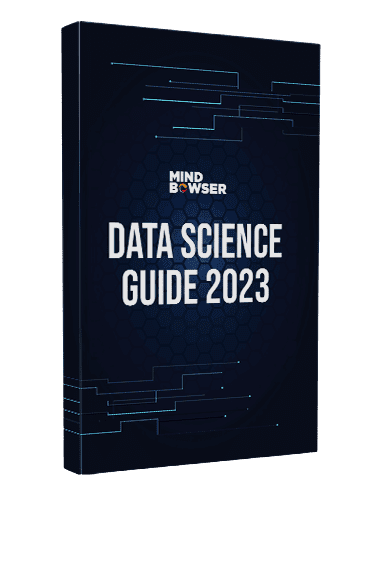The most basic way of gathering information is by doing it manually- for example, copying and pasting everything by hand. This works well if the data you need to collect is small in quantity. However, web scraping is the best solution for managing data at scale.
Web data scraping is a process that uses intelligent automation to get large amounts of data from other websites in a shorter amount of time than manual methods. In this article, we will learn in-depth about web scraping, how it works, and how to use it to get data from other websites.
There are various ways to collect data from sources automatically, but they all boil down to web data scraping. This process usually involves extracting unstructured data from HTML pages and converting it into a more structured format like a database. That way, it can be used for varied purposes.
You can perform web scraping in different ways, such as online services, particular APIs, or creating your code from scratch. Many large websites have APIs that let you access their data in a structured way.


The internet has a lot of information that can be accessed. However, from a business perspective, only some information available online will be helpful for your brand.
This is where web scraping plays the role. Web scraping allows you to extract only relevant information. For example, you can scrape data about competitor pricing strategies, customer reviews, and feedback about new product launches.
With more competitors in the market, you will need to step up the game to remain competitive. One way to stay competitive is to use web scraping services to reach clients before the competitors are even aware of their existence.
Web scraping can be a helpful way to gather information about your customer behavior, their expectations for a particular product, and what solutions they think a product should offer. This data can help you improve the current key and make it significantly easier to sell.
Only some brands display their data to the audience. But you can have an advantage doing so. The data normally shown is only sometimes the data that would be most beneficial for a brand. For instance, if a brand displayed its organization’s roots, history, and achievements, how could you benefit from it?
The use of web scraping can fill this gap. With web data scraping, you can easily extract all other information that a brand hides from the public eye. This data can be used to improve your current solution to make it the ultimate source of leads for your brand. The conversion rate of such leads is higher because the solution meets their expectations.
Web scraping can be a great help when it comes to finding leads. With so much competition, finding the right leads and converting them into sales can take time and effort. However, you can find the leads you need quickly and efficiently with web scraping services.
Web scraping can help extract data on leads from a variety of sources. The data can be scraped with a few clicks and collected in the database. Collecting this data will allow you to quickly and easily assess which leads are worth pursuing.
Nurturing leads is a crucial part of the sales process, but it can be time-consuming and repetitive. Automation can take some of the load off by automatically conducting tasks like lead nurturing. Web scraping is one way to automate this process successfully.
Web scraping can be a valuable solution for brands looking to collect relevant data and apply it to marketing strategies. By automating the web scraping process, brands can speed up the data collection process and ensure they always have access to quality information. This data can then be used to automate other business processes.
Bots are increasingly taking over the business world, requiring a lot of data to function properly. Web data scraping can provide the data they need to function like humans, conducting tests and setting up commands. This use of data with machine learning can help brands enhance their performance in many ways.


It’s crucial to check the terms of service for the website you are scraping. This will ensure that you are not breaching any rules and avoid any potential problems down the road. Additionally, getting permission from the website owner before scraping their site is always a good idea.
Many web scraping tools are available, so it can take time to choose the right one. Many web scraping tools are available, out of which choosing the right tool is essential.
Scrapy is a web scraping framework that lets you scrape data from websites quickly and easily. It’s one of the most popular web scraping tools, used by big names like Google, Yahoo, and Facebook.
ParseHub is a popular web scraping tool that supports various languages and platforms. With ParseHub, you can easily extract data from websites and use it for your purposes.
Error-handling techniques can help you deal with expectations, such as network errors, website structure changes, and CAPTCHAs. Using these techniques, you can improve your website’s resilience and avoid potential problems.
You must only send a few requests at a time when collecting data from websites and overloading their servers. If you do, your IP address could get banned from the site. To prevent this from happening, space out your requests so you only make a few at a time.
Sometimes, a website needs the data you need. When this happens, it’s important to know when to stop and move on. Save your time trying to force your web scraper to work. Other websites have the data you need.
The legal aspects of web scraping are complex and vary depending on the country, region, and jurisdiction. In general, web scraping services is not illegal, but it can become illegal if it infringes on someone else’s right. Here are a few key legal considerations for web scraping;
🔸 Copyright Law: Scraping may infringe on a website’s copyright if the scraped content is original and creative.
🔸 Contract Law: If a website has terms of use prohibiting scraping, the act of scraping may be a breach of contract.
🔸 Privacy Law: Web scraping can also raise privacy concerns, particularly if it involves scraping personal data or confidential information.
The legal landscape of web data scraping is constantly evolving and can be complex. Hence, seeking legal advice is important before engaging in web scraping activities. Additionally, it’s always a good idea to respect websites and their terms of use and ensure you have the necessary permissions before scraping data.

Web scraping is a powerful tool for data collection and can be applied in various fields. It allows you to gather information from websites and turn it into structured data, making it easier to analyze and work with.
First, it’s important to understand the ethical and legal considerations surrounding web data scraping and the technical aspects, such as choosing the right tool, handling dynamic websites, and avoiding bans by website owners. With the right approach, web scraping can be a valuable resource for businesses and individuals looking to gather information and insights from the web.

Free Data Science eBook – A Complete Guide

I'm thrilled to be partnering with Mindbowser on our journey with TravelRite. The collaboration has been exceptional, and I’m truly grateful for the dedication and expertise the team has brought to the development process. Their commitment to our mission is...

Founder & CEO, TravelRite

The Mindbowser team's professionalism consistently impressed me. Their commitment to quality shone through in every aspect of the project. They truly went the extra mile, ensuring they understood our needs perfectly and were always willing to invest the time to...

CTO, New Day Therapeutics

I collaborated with Mindbowser for several years on a complex SaaS platform project. They took over a partially completed project and successfully transformed it into a fully functional and robust platform. Throughout the entire process, the quality of their work...

President, E.B. Carlson

Mindbowser and team are professional, talented and very responsive. They got us through a challenging situation with our IOT product successfully. They will be our go to dev team going forward.

Founder, Cascada

Amazing team to work with. Very responsive and very skilled in both front and backend engineering. Looking forward to our next project together.

Co-Founder, Emerge

The team is great to work with. Very professional, on task, and efficient.

Founder, PeriopMD

I can not express enough how pleased we are with the whole team. From the first call and meeting, they took our vision and ran with it. Communication was easy and everyone was flexible to our schedule. I’m excited to...

Founder, Seeke

Mindbowser has truly been foundational in my journey from concept to design and onto that final launch phase.

CEO, KickSnap

We had very close go live timeline and Mindbowser team got us live a month before.

CEO, BuyNow WorldWide

If you want a team of great developers, I recommend them for the next project.

Founder, Teach Reach

Mindbowser built both iOS and Android apps for Mindworks, that have stood the test of time. 5 years later they still function quite beautifully. Their team always met their objectives and I'm very happy with the end result. Thank you!

Founder, Mindworks

Mindbowser has delivered a much better quality product than our previous tech vendors. Our product is stable and passed Well Architected Framework Review from AWS.

CEO, PurpleAnt

I am happy to share that we got USD 10k in cloud credits courtesy of our friends at Mindbowser. Thank you Pravin and Ayush, this means a lot to us.

CTO, Shortlist

Mindbowser is one of the reasons that our app is successful. These guys have been a great team.

Founder & CEO, MangoMirror

Kudos for all your hard work and diligence on the Telehealth platform project. You made it possible.

CEO, ThriveHealth

Mindbowser helped us build an awesome iOS app to bring balance to people’s lives.

CEO, SMILINGMIND

They were a very responsive team! Extremely easy to communicate and work with!

Founder & CEO, TotTech

We’ve had very little-to-no hiccups at all—it’s been a really pleasurable experience.

Co-Founder, TEAM8s

Mindbowser was very helpful with explaining the development process and started quickly on the project.

Executive Director of Product Development, Innovation Lab

The greatest benefit we got from Mindbowser is the expertise. Their team has developed apps in all different industries with all types of social proofs.

Co-Founder, Vesica

Mindbowser is professional, efficient and thorough.

Consultant, XPRIZE

Very committed, they create beautiful apps and are very benevolent. They have brilliant Ideas.

Founder, S.T.A.R.S of Wellness

Mindbowser was great; they listened to us a lot and helped us hone in on the actual idea of the app. They had put together fantastic wireframes for us.

Co-Founder, Flat Earth

Ayush was responsive and paired me with the best team member possible, to complete my complex vision and project. Could not be happier.

Founder, Child Life On Call

The team from Mindbowser stayed on task, asked the right questions, and completed the required tasks in a timely fashion! Strong work team!

CEO, SDOH2Health LLC

Mindbowser was easy to work with and hit the ground running, immediately feeling like part of our team.

CEO, Stealth Startup

Mindbowser was an excellent partner in developing my fitness app. They were patient, attentive, & understood my business needs. The end product exceeded my expectations. Thrilled to share it globally.

Owner, Phalanx

Mindbowser's expertise in tech, process & mobile development made them our choice for our app. The team was dedicated to the process & delivered high-quality features on time. They also gave valuable industry advice. Highly recommend them for app development...

Co-Founder, Fox&Fork
